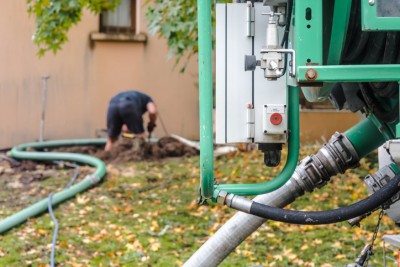How Do Septic Tanks/Cesspools Get Emptied?
Flushing away toilet waste is not something that people often like to think about! As the saying goes, ‘out of sight, out of mind’. For a property that has a mains sewage system, this is a reasonable statement, in the sense that unless something goes wrong, like a leaking pipe, you can leave the system to function for years or decades without any worries.
But if you have a septic tank or a cesspool, it is not quite true – ‘out of sight, out of mind’ could lead to expensive and smelly problems. It is recommended that you have these emptied regularly, with a frequency that depends on the size of the tank, the amount of use and the number of people.
At RMS Waste, we specialise in a range of services for waste products, including septic tank emptying services. But how exactly are these systems emptied? To understand that you need to understand what each one is and how it works.
A cesspit is the simplest of waste systems. It simply consists of a sealed tank in the ground. Each time that waste is flushed away, it collects in the tank. Because it is sealed, it cannot escape to anywhere. Cesspit emptying involves a hose being attached to the outlet. By means of a strong pump, the mixture of solids and liquids is sucked out into a specially designed tanker. This can then be driven to a registered disposal centre, where it can be safely disposed of. Because this is the only way of safely emptying the system, it needs to be done regularly. If it is used less often and has a large tank, you might have it emptied once a year, but for more frequent use, it might need to be emptied as often as every three months. Fortunately, with our professionals at RMS waste, the cesspool emptying cost is low, so this is affordable.
The septic tank emptying Hampshire customers require is very similar. Septic tanks also have a large container that is under ground, and the waste flushes into it. However, there are a few key differences. One is that the container often has more than one chamber. More importantly it has an outlet in the system, as well as an outlet for sewage tank emptying. This is because a septic system will self-regulate if it is maintained. The waste in the tank separates into three layers – on the top, is a layer of oils and greases, known as scum. Underneath that is a liquid layer of wastewater. The bottom is all the heavier solids, which make a sludge at the bottom of the tank. Bacteria in the wastewater breaks down the sludge so that water is released, leaving only the heavier solids. The wastewater is then able to leave the outlet. It is fed out through a system of pipes into a drainage field, where it is released into the soil at a controlled rate. This system will maintain itself quite well, however from time to time, it needs emptying. This is similar to the cesspit emptying process and uses a hose with a pump to fill a tanker. This removes the scum from the top, as well as the sludge from the bottom. This is usually done about once a year, although our experts can advise you on your system. If this is not done, there are two risks – one is that the system can back up and block, which causes problems, not to mention smells. The other problem is that the bacteria can be killed off, meaning that the system is no longer effective.
You probably did not realise that there was so much involved in cesspits and septic tanks! Fortunately, you do not need to handle them on your own. Let our team of experts help. All you need to do is contact us using the details on the website.


